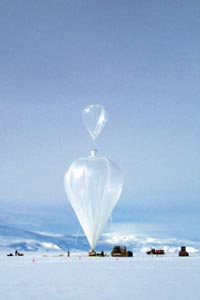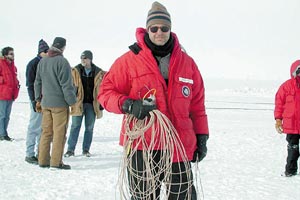‘TopHat’ collects data on origin of the universe
A University experiment that has been seeking new insights into the origin and evolution of the universe has come to a successful conclusion, following a 27-day balloon journey high above Antarctica. A 1-meter telescope, used to get an unobstructed view of the sky, sits atop the balloon being used in the TopHat experiment in Antarctica. |
Scientists recovered the experiment’s data tapes Wednesday, Jan. 31, after landing their Twin Otter aircraft in remote west Antarctica between a rock field, two steep glacial slopes and a deadly crevasse.
“This balloon flight was certainly one heck of an adventure,” said Stephan Meyer, Professor in Astronomy & Astrophysics. “We’ve been successful and lucky. We’re happy with that.”
The experiment, called TopHat, was the first ever launched by the National Scientific Balloon Facility with a payload sitting on top of the balloon. TopHat scientists placed their 1-meter telescope atop the balloon to get an unobstructed view of the sky.
“We have at least six days of data, which is roughly 20 times as much data as we normally get from a balloon flight. That’s the thing that’s going to make this whole operation so much fun,” said Meyer, who leads the international TopHat collaboration.
Working with Meyer are researchers from the Danish Space Research Institute, NASA’s Goddard Space Flight Center and the University of Wisconsin at Madison. The $2 million experiment is supported by grants from the National Science Foundation and the National Aeronautics and Space Administration.
 Stephan Meyer holds the test wires for the top package of the balloon instrument. |
TopHat’s telescope operates as a heat detector that records tiny temperature differences in the cosmic microwave background radiation, the big bang’s afterglow. The sun shines 24 hours a day during Antarctic summers, creating favorable conditions for long-duration balloon experiments. More dramatic daily temperature variations at mid-latitudes lead to helium leakage, limiting flights to three or four days.
TopHat is the most recent in a series of astrophysical experiments to have heralded the era of precision cosmology, the study of the universe’s origin and evolution. As recently as the early 1960s, Meyer said, cosmology lacked a key element of science: the ability to make predictions that experiments could verify. “That’s totally changed. Now we’re in a situation where these are precision predictions and precision measurements.”
Before his death in 1997, the late David Schramm, a Chicago astrophysicist, made some key predictions. Schramm’s calculations helped show that the element deuterium could be used to estimate how much of the universe consists of baryons––protons, neutrons and electrons, the building blocks of ordinary matter. His calculations further showed that only 5 percent of the universe consists of baryons.
Cosmic microwave background measurements permit astrophysicists to experimentally estimate the universe’s baryonic density. Last year, an Antarctic balloon experiment called BOOMERANG (Balloon Observations of Millimetric Extragalactic Radiation and Geophysics), measured a baryonic density of approximately 7.5 percent. Another balloon experiment, called MAXIMA (Millimeter Anisotropy Experiment Imaging Array), measured a slightly lower baryonic value. And a ground-based experiment, the Cosmic Background Imager, came up with a still lower value.
“There are significant differences between the three experiments. The theoretical consequences for those differences is rather striking,” Meyer said. “The experiment with the first and perhaps the most precise answer, BOOMERANG, has the result that is most inconsistent with what people had thought was true before. That doesn’t make it wrong. It was just surprising.”
TopHat’s advantage over BOOMERANG is that it measures a much larger section of the sky––an important aspect of microwave background experiments––with approximately the same sensitivity. But the TopHat team will need approximately a year to analyze its results.
The next experiment that will produce microwave background results will be the University’s Degree Angular Scale Interferometer. DASI has been taking data from the South Pole for more than a year. The project leader, John Carlstrom, the Subramanyan Chandrasekhar Distinguished Service Professor in Astronomy & Astrophysics, has nearly completed his analysis.
“DASI should be able to narrow that error on the microwave background number and ask, did Schramm get it right? Almost right?” said Michael Turner, the Bruce V. and Diana M. Rauner Distinguished Service Professor and Chairman of Astronomy & Astrophysics. “I’m betting that the microwave background number is going to come down.”
The Microwave Anistropy Probe, which NASA has scheduled for launch June 30, will make the most definitive microwave background measurements. Meyer is a member of the MAP science team.
“If everything turns out as the theorists expected, then we would basically be able to close the book on this aspect of cosmology,” Meyer said. “I fully expect there to be some surprises. I don’t know what they’ll be.”
For more information, about the TopHat experiment, see http://topweb.gsfc.nasa.gov/.
![[Chronicle]](/images/small-header.gif)